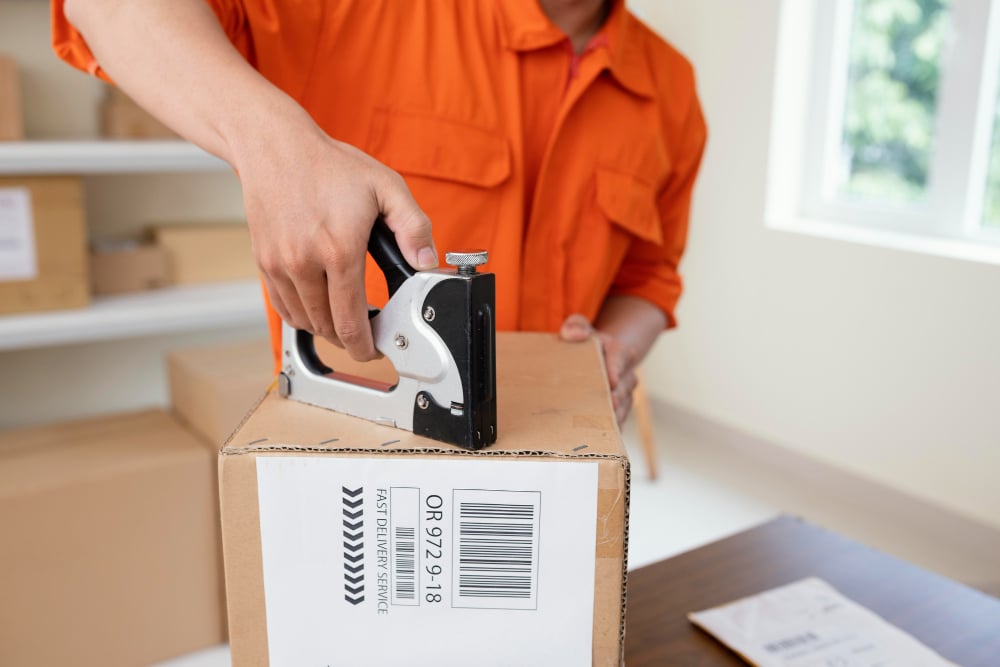The journey of a package from sender to recipient involves numerous steps, with one of the most crucial being labeling. Shipping labels serve as passports for parcels, guiding them through transit networks and ensuring they reach their destination accurately and efficiently.
However, not all packages are created equal, nor should their labels be. Tailoring shipping labels to match specific package types streamlines the shipping process and enhances brand identity and customer satisfaction.
What is a Shipping Label?
A shipping label is a piece of documentation affixed to a package or parcel that provides information about the package’s contents, the origin and destination addresses, and any handling instructions.
It typically includes details such as the sender’s address, the recipient’s address, tracking numbers, and sometimes special instructions for delivery or handling. Shipping labels are essential for ensuring that packages are correctly routed and delivered to the intended recipient.
They can be generated electronically through shipping software or platforms or printed manually and attached to the package.

Benefits of a Well-Designed Shipping Label
A well-designed shipping label offers numerous benefits across various aspects of the logistics process:
- Enhanced Accuracy in Shipment Handling: Clear and concise information on the label reduces the likelihood of errors in processing and ensures that the shipment reaches its intended destination accurately.
- Improved Efficiency in Logistics Operations: Well-designed labels with barcode or QR code integration facilitate faster scanning and processing, leading to smoother logistics operations and reduced handling times.
- Easier Tracking and Management of Shipments: Barcode or tracking numbers prominently displayed on the label make tracking shipments throughout the supply chain easier, enabling better management and oversight.
- Compliance with Carrier and Regulatory Standards: A properly formatted shipping label ensures compliance with carrier requirements and regulatory standards, minimizing the risk of delays or rejections during transit.
- Reduced Risk of Lost or Misdirected Shipments: Clear labeling with accurate recipient details reduces the chances of shipments getting lost or misrouted, thereby minimizing disruptions and potential costs associated with re-routing.
- Better Customer Satisfaction with Clear Information: Detailed shipping labels provide customers with essential information regarding their orders, such as shipping dates, delivery estimates, and tracking details, enhancing transparency and trust in the shipping process.
- Streamlined Returns and Exchange Processes: Well-designed labels often include return instructions and addresses, making it easier for customers to initiate returns or exchanges. Thus, the reverse logistics process is streamlined.
- Increased Brand Professionalism and Consistency: Consistently designed shipping labels with branded elements convey professionalism and reliability, contributing to a positive brand image and customer perception.
Components of a Shipping Label
- Sender’s Name and Address: This includes the name and full address of the person or company sending the package.
- Recipient’s Name and Address: This includes the name and full address of the person or company receiving the package.
- Package Weight and Dimensions: Information about the package’s weight and dimensions helps determine shipping costs and handling.
- Tracking Number or Barcode: A unique identifier assigned to the package to track its movement throughout the shipping process.
- Carrier Name and Logo: The name and logo of the shipping company responsible for delivering the package.
- Shipping Class or Service Type: Indication of the shipping service selected, such as standard ground, expedited, overnight, etc.
- Date of Shipment: The date when the package was sent out for delivery.
- Special Handling Instructions (if applicable): Any specific instructions for handling the package, such as “fragile” or “this side up.”
- Return Address (if different from the sender’s address): If the package needs to be returned, this is the address it should be returned to.
- Fragile or Hazardous Material Indicators (if applicable): Warnings or symbols indicating if the package contains fragile items or hazardous materials.
Types of Shipping Labels
Each shipping label serves a specific purpose and helps ensure packages are handled and delivered appropriately. Here’s a brief description of each:
- Standard Mailing Labels are the basic labels for regular domestic shipments. They typically include the sender’s and recipient’s addresses.
- International Shipping Labels: Similar to standard mailing labels, but include additional fields such as customs information, including the contents and value of the package.
- Return Shipping Labels: These labels are included in outbound shipments to facilitate returns. They typically feature the sender’s address as the return address.
- Fragile and Special Handling Labels: These labels indicate that the package contains fragile items or requires special care during handling.
- Hazardous Material Labels: These labels are required for packages containing hazardous materials. They include symbols and text indicating the type of hazard present.
- Thermal Printing Labels: These labels are designed for use with thermal printers, which produce high-quality, durable labels without the need for ink or toner.
- Custom Branded Labels: These labels feature a company’s logo or branding elements, providing a professional and consistent package look.
- Electronic or E-labels: These digital labels can be transmitted electronically, eliminating the need for physical labels. They are commonly used in industries where tracking and real-time updates are essential.

8 Shipping Label Template Ideas for Your Business
1. Basic E-commerce Shipping Label
E-commerce shipping labels are essential for businesses selling products online. They contain crucial information for both the sender and the recipient, facilitating smooth delivery. This basic template includes sender and recipient details, shipping date, carrier information, optional return address, and special instructions.
| [Your Business Logo Here] From: [Your Business Name] [Your Business Address Line 1] [City, State, Zip] To: [Customer’s Name] [Customer’s Address Line 1] [City, State, Zip] [BARCODE/QR CODE FOR TRACKING] Carrier: [Carrier Name] – [Shipping Service Type] Date: [Shipping Date] Return Address (if applicable): [Return Address Line 1] [City, State, Zip] Special Instructions: [Any Special Delivery Instructions] |
2. Subscription Box Shipping Label
Subscription box shipping labels are tailored for businesses that offer subscription services. These labels often include branding elements and may contain information specific to the subscription, such as the subscription type or renewal date.
| [Your Business Logo Here] From: [Your Business Name] [Your Business Address Line 1] [City, State, Zip] To: [Subscriber’s Name] [Subscriber’s Address Line 1] [City, State, Zip] [BARCODE/QR CODE FOR TRACKING] Carrier: [Carrier Name] – [Shipping Service Type] Date: [Shipping Date] Subscription Type: [Type of Subscription] Renewal Date: [Renewal Date] Return Address (if applicable): [Return Address Line 1] [City, State, Zip] Special Instructions: [Any Special Delivery Instructions] |
3. Fragile Item Shipping Label
Fragile item shipping labels are designed to alert handlers and recipients that the package contains delicate or breakable items. These labels typically feature prominent “Fragile” warnings and may include handling instructions.
| [Your Business Logo Here] From: [Your Business Name] [Your Business Address Line 1] [City, State, Zip] To: [Recipient’s Name] [Recipient’s Address Line 1] [City, State, Zip] [BARCODE/QR CODE FOR TRACKING] Carrier: [Carrier Name] – [Shipping Service Type] Date: [Shipping Date] FRAGILE – HANDLE WITH CARE Return Address (if applicable): [Return Address Line 1] [City, State, Zip] Special Instructions: [Any Special Delivery Instructions] |
4. International Shipping Label
International shipping labels are necessary for packages being sent across borders. These labels include additional information, such as customs declarations and international tracking numbers, and may require translations of key details.
| [Your Business Logo Here] From: [Your Business Name] [Your Business Address Line 1] [City, State, Zip] To: [Recipient’s Name] [Recipient’s Address Line 1][ City, Province/Region, Postal Code] [Country] [BARCODE/QR CODE FOR TRACKING] Carrier: [Carrier Name] – [Shipping Service Type] Date: [Shipping Date] Customs Declaration: [Description of Contents, Value, etc.] Return Address (if applicable): [Return Address Line 1] [City, State, Zip] Special Instructions: [Any Special Delivery Instructions] |
5. Return Shipping Label
Return shipping labels are crucial for businesses offering returns or exchanges. These labels typically include instructions for the recipient on how to return the package to the sender, along with any necessary authorization or tracking information.
| [Your Business Logo Here] From: [Your Business Name] [Your Business Address Line 1] [City, State, Zip] To: [Your Business Name] [Your Business Address Line 1] [City, State, Zip] [BARCODE/QR CODE FOR TRACKING] Carrier: [Carrier Name] – [Shipping Service Type] Date: [Shipping Date] Return Authorization Number: [Authorization Number] Special Instructions: [Any Special Delivery Instructions] |
6. Refrigerated Goods Shipping Label
Refrigerated goods shipping labels are designed for packages containing perishable items that require temperature control during transit. These labels often include temperature-sensitive indicators and handling instructions for carriers.
| [Your Business Logo Here] From: [Your Business Name] [Your Business Address Line 1] [City, State, Zip] To: [Recipient’s Name] [Recipient’s Address Line 1] [City, State, Zip] [BARCODE/QR CODE FOR TRACKING] Carrier: [Carrier Name] – [Refrigerated Shipping Service Type] Date: [Shipping Date] REFRIGERATED – HANDLE WITH CARE Temperature Range: [Temperature Range] Temperature Indicator: [Indicator Status] Return Address (if applicable): [Return Address Line 1] [City, State, Zip] Special Instructions: [Any Special Delivery Instructions] |
7. Oversized Package Label
Oversized package labels are for packages that exceed standard size limits for shipping. These labels help carriers appropriately identify and handle large items, ensuring safe and efficient delivery.
| [Your Business Logo Here] From: [Your Business Name] [Your Business Address Line 1] [City, State, Zip] To: [Recipient’s Name] [Recipient’s Address Line 1] [City, State, Zip] [BARCODE/QR CODE FOR TRACKING] Carrier: [Carrier Name] – [Shipping Service Type] Date: [Shipping Date] OVERSIZED PACKAGE – HANDLE WITH CARE Return Address (if applicable): [Return Address Line 1] [City, State, Zip] Special Instructions: [Any Special Delivery Instructions] |
8. Hazardous Material Shipping Label
Hazardous material shipping labels are essential for packages containing substances deemed hazardous or potentially dangerous during transit. These labels must comply with regulatory requirements and include specific hazard symbols and handling instructions.
| [Your Business Logo Here] From: [Your Business Name] [Your Business Address Line 1] [City, State, Zip] To: [Subscriber’s Name] [Subscriber’s Address Line 1] [City, State, Zip] [BARCODE/QR CODE FOR TRACKING] Carrier: [Carrier Name] – [Shipping Service Type] Date: [Shipping Date] HAZARDOUS MATERIAL – HANDLE WITH CARE Hazard Class: [Hazard Class] UN Number: [UN Number] Return Address (if applicable): [Return Address Line 1] [City, State, Zip] Special Instructions: [Any Special Delivery Instructions] |
Generate the Right Shipping Label for your Business
In conclusion, having the right shipping label for your business is essential for ensuring smooth and efficient delivery of your products to customers. Whether you’re shipping e-commerce orders, subscription boxes, fragile items, or international packages, using the appropriate label can help streamline the shipping process and enhance the customer experience.
To help you get started, we’ve provided a variety of free downloadable shipping label templates tailored to different business needs. With these templates, you can confidently create professional-looking shipping labels that reflect your brand and ensure your packages arrive safely and on time.
Thank you for exploring our shipping label template ideas, and we wish you success in your shipping endeavors!










